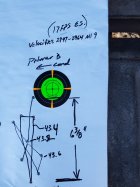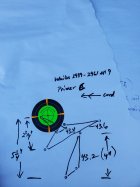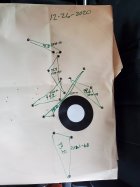You are using an out of date browser. It may not display this or other websites correctly.
You should upgrade or use an alternative browser.
You should upgrade or use an alternative browser.
338-300 Norma Improved 35 degree
- Thread starter tom
- Start date
tom
Gold $$ Contributor
Have you tried mandrels for desired neck tension vs bushings to see if it makes a difference?
ie, 360 bushing and then 334 or 335 mandrel etc
On the 338 no, but in the past with other cases yes. Most of my experience lies with 6mm's for 1,000 yard benchrest. After quite a bit of data collection, as in years, I decided you could successfully equal the precision using just bushings to set tension. I couldn't however, say I ever found a method that could beat it hands down...or at least not by enough to tell. I wound up coming back to "finding the bushing it likes" as my preferred method. The reasons are no real provable gains, and because I'm pretty dumb at times, so adding steps to any process to get to the same point, would likely bite me in the butt one day when I forgot a step. One thing I learned is that you want to make sure to not "scratch" the existing powder residue in the necks if you're going to employ a mandrel method. 2017, the first year i tried the 6 bra, I set a 10 match heavy gun agg record and was setting tension with a mandrel. It can work, just like finding the right bushing.
Tom
tom
Gold $$ Contributor
As far as the neck tension is what I'm assuming you're asking?I learn a lot from reading threads like this but am so lost.
Is there a good source, videos preferably, someone can recommend to show what is being discussed here for reloading?
*There are standard full length sizing dies, which have a fixed I.D. at the neck (smaller than required). They also have a button on the decaping stem which is usually a couple thousandths under bullet diameter. The only adjustability to how much grip you'd want on the bullet would be to get/make custom sized buttons.
*There are full length "bushing style" dies(which is what I prefer). They have no expander button option(which i also prefer), but do ship with one as well. On these you just switch bushings to adjust/change how much grip to put on your bullet.
*There are dies specifically just to hold an expander mandrel(much better than the button style IMO). You can use these as a last step to "set" the desired grip, after one of the full length dies.
@whatwind? Was asking if I tried the expander mandrel method to set my grip on bullets.
The rest of the thread is mostly just testing powder charges, or testing seating depths. Alex was referring to how the powder charge testing shaped/acted differently with the use of different "grip". Which is quite true, and even more obvious on stuff we use for benchrest. Unfortunately the type rifle we're discussing here can't be ran in 15 shot "ladders" like we do on target rifles. In this case, I shoot a couple foulers in the dirt in the darkness of morning. Once it's cool, I shoot a 3 shot group. And repeat every 20-30 minutes, or however long it takes for everything to come back to ambient temperature. I spend more trips on something like this, since we can't be sure conditions aren't influencing P.O.I. a bit. After a while we see a pattern that repeats. On a bench gun you can see "grip" affecting the width of the powder node, and also the size of the groups as it falls below and climbs above the node. You can also see this affected by primer choice.
Basically by using one aim point for the session, we compare and look at how the point of impact climbs, and then stops.....sort of trying to read into it what you would with a true "ladder test"
Here's an example, last weekend was ridiculous windy. To windy to shoot a group every 30 minutes and learn anything from it. So I did a couple ladders with a new 6mm heavy bullet "Big J" a friend is making. The second of those ladders started at the same charge that the first one ended. This allows me to cut the ladder on the right, line up the charges and results in a tall ladder that covers a lot of ground/nodes. See below.

With these rifles, at these type capacities, we can run 12-15 shots after some sighters in about 30 seconds. This is pointing out the spots where it stops climbing, and are our spots to concentrate on going forward. We do these type (single aimpoint) tests with powder and seating depths. Do them with different "grip", do them with different primers....ect.
Hopefully this helps,
Tom
tom
Gold $$ Contributor
Now what?
Do you back off powder a bit to combat the speed up?
Change primers, or powder?
Neck tension has been determined already.
When you test I'm listening, I've learned a lot following your tests.
I'll explore a bit above in this case, and possibly below depending how that goes. Generally shooting groups at powder incrementally until it steadies for velocities. Trying the whole time to remember it's a bipod gun shooting a 300 grain bullet and not a 6mm. Repeating a seating depth test at some point after it settles and hopefully at that time I'll have a good idea of the powder node I want.
Tom
tom
Gold $$ Contributor
Now what?
Do you back off powder a bit to combat the speed up?
Change primers, or powder?
Neck tension has been determined already.
When you test I'm listening, I've learned a lot following your tests.
Will also once it stabilizes do up and down on powder with different primers as well. My primer stash isn't the greatest at the moment, so I want it to be done seasoning first.
Tom
Shoot me a PM, maybe I can help a littleWill also once it stabilizes do up and down on powder with different primers as well. My primer stash isn't the greatest at the moment, so I want it to be done seasoning first.
Tom
DHuffman
Silver $$ Contributor
I have a hard time with this as well. Once you shoot a bench gun off a rest most everything else looks like ass for me.......Trying the whole time to remember it's a bipod gun shooting a 300 grain bullet and not a 6mm.
Tom
Alex Wheeler
Site $$ Sponsor
The problem is, we have shot enough 1"s and 2"s with the 338s to know they can do it. Getting them to do it a little more regularly is what we are working on.
As far as the neck tension is what I'm assuming you're asking?
*There are standard full length sizing dies, which have a fixed I.D. at the neck (smaller than required). They also have a button on the decaping stem which is usually a couple thousandths under bullet diameter. The only adjustability to how much grip you'd want on the bullet would be to get/make custom sized buttons.
*There are full length "bushing style" dies(which is what I prefer). They have no expander button option(which i also prefer), but do ship with one as well. On these you just switch bushings to adjust/change how much grip to put on your bullet.
*There are dies specifically just to hold an expander mandrel(much better than the button style IMO). You can use these as a last step to "set" the desired grip, after one of the full length dies.
@whatwind? Was asking if I tried the expander mandrel method to set my grip on bullets.
The rest of the thread is mostly just testing powder charges, or testing seating depths. Alex was referring to how the powder charge testing shaped/acted differently with the use of different "grip". Which is quite true, and even more obvious on stuff we use for benchrest. Unfortunately the type rifle we're discussing here can't be ran in 15 shot "ladders" like we do on target rifles. In this case, I shoot a couple foulers in the dirt in the darkness of morning. Once it's cool, I shoot a 3 shot group. And repeat every 20-30 minutes, or however long it takes for everything to come back to ambient temperature. I spend more trips on something like this, since we can't be sure conditions aren't influencing P.O.I. a bit. After a while we see a pattern that repeats. On a bench gun you can see "grip" affecting the width of the powder node, and also the size of the groups as it falls below and climbs above the node. You can also see this affected by primer choice.
Basically by using one aim point for the session, we compare and look at how the point of impact climbs, and then stops.....sort of trying to read into it what you would with a true "ladder test"
Here's an example, last weekend was ridiculous windy. To windy to shoot a group every 30 minutes and learn anything from it. So I did a couple ladders with a new 6mm heavy bullet "Big J" a friend is making. The second of those ladders started at the same charge that the first one ended. This allows me to cut the ladder on the right, line up the charges and results in a tall ladder that covers a lot of ground/nodes. See below.
View attachment 1221862
With these rifles, at these type capacities, we can run 12-15 shots after some sighters in about 30 seconds. This is pointing out the spots where it stops climbing, and are our spots to concentrate on going forward. We do these type (single aimpoint) tests with powder and seating depths. Do them with different "grip", do them with different primers....ect.
Hopefully this helps,
Tom
Thanks for that awesome right up.
I meant in general, not necessarily the bushing dies or expanders. There is so much information about reloading for accuracy and the neck tension is just part of it. I've started using bushing dies when I got into longer range precision, specifically with my 300NM.
I've been reloading for 6 or 7 years but only the last year or so for precision. ELR is what I'm mainly interested in and shoot. But I want my loads to be spot on.
tom
Gold $$ Contributor
Thanks for that awesome right up.
I meant in general, not necessarily the bushing dies or expanders. There is so much information about reloading for accuracy and the neck tension is just part of it. I've started using bushing dies when I got into longer range precision, specifically with my 300NM.
I've been reloading for 6 or 7 years but only the last year or so for precision. ELR is what I'm mainly interested in and shoot. But I want my loads to be spot on.
@GlennK Really has his 30 cal version shooting well. I will have one of those eventually myself.
Tom
tom
Gold $$ Contributor
Started today at 110 rounds, fired 2 foulers in the dark and shot a few groups in the high node.... then shot the same 3 groups but with federal 210s.... hmmmmmmm, lol

I think I'm about done shooting paper, it can only get worse! The way I set the lab radar up is making me wonder if there's not a bit of error in some of the more erroneous readings as well.
Tom

I think I'm about done shooting paper, it can only get worse! The way I set the lab radar up is making me wonder if there's not a bit of error in some of the more erroneous readings as well.
Tom
Last edited:
Ledd Slinger
Silver $$ Contributor
Nice. That’s an amazing target.
Just goes to show that every barrel is unique and because a certain primer works better with 10 other rifles doesn’t mean it will be better in every barrel.
I know this is a target rifle but there has always been a general consensus to use a magnum primer in cases with over 60gr charge weights being used in cold weather. However, I think that theory was developed a long time ago based on certain powders and their particular ignition properties. Today’s powders are more advanced for sure. If N570 will ignite properly and consistently with 95+ grains in front of a standard LR primer then so be it. Might as well try some CCI 200s as well to see if they also perform better than the 250 magnum.
Just goes to show that every barrel is unique and because a certain primer works better with 10 other rifles doesn’t mean it will be better in every barrel.
I know this is a target rifle but there has always been a general consensus to use a magnum primer in cases with over 60gr charge weights being used in cold weather. However, I think that theory was developed a long time ago based on certain powders and their particular ignition properties. Today’s powders are more advanced for sure. If N570 will ignite properly and consistently with 95+ grains in front of a standard LR primer then so be it. Might as well try some CCI 200s as well to see if they also perform better than the 250 magnum.
tom
Gold $$ Contributor
Yep. Just because a certain primer works better with 10 other rifles doesn’t mean it will be better every time.
I know this is a target rifle but there has always been a general consensus to use a magnum primer in cases with over 60gr charge weights being used in cold weather. However, I think that theory was developed a long time ago based on certain powders and their particular ignition properties. Today’s powders are more advanced for sure. If N570 will ignite properly and consistently with 95+ grains in front of a standard LR primer then so be it. Might as well try some CCI 200s as well to see if they also perform better than the 250 magnum.
It's a bipod gun/truck gun. But it is heavy enough (barely) to shoot well enough to see whats happening. Today is a perfect example of why I would not only load 96.2 for example and compare primers. Personally, with the barrel i started the thread with, it just couldn't handle it's own recoil well enough. An actual target version might someday be in order, as this is about as good as 338s as we've seen.
Tom
Last edited:
Ledd Slinger
Silver $$ Contributor
Oh I thought you were tuning it for the 2K match.It's a bipod gun/truck gun. But it is heavy enough (barely) to shoot well enough to see whats happening.
Tom
Last edited:
Alex Wheeler
Site $$ Sponsor
Its just shy of making it to 2k super sonic. The 338 Lapua imp and 300 Norma imp seem like the minimum. I have some different barrels speced out to see if I can find a little more velocity, but I still think the 338 Norma Imp will come up just short. It would be an awesome mile gun though. Below is a pic of the rifle Tom is tuning up now. 

Similar threads
- Replies
- 21
- Views
- 735
- Replies
- 56
- Views
- 13,178
- Replies
- 0
- Views
- 351
Upgrades & Donations
This Forum's expenses are primarily paid by member contributions. You can upgrade your Forum membership in seconds. Gold and Silver members get unlimited FREE classifieds for one year. Gold members can upload custom avatars.

Click Upgrade Membership Button ABOVE to get Gold or Silver Status.
You can also donate any amount, large or small, with the button below. Include your Forum Name in the PayPal Notes field.
To DONATE by CHECK, or make a recurring donation, CLICK HERE to learn how.

Click Upgrade Membership Button ABOVE to get Gold or Silver Status.
You can also donate any amount, large or small, with the button below. Include your Forum Name in the PayPal Notes field.
To DONATE by CHECK, or make a recurring donation, CLICK HERE to learn how.













